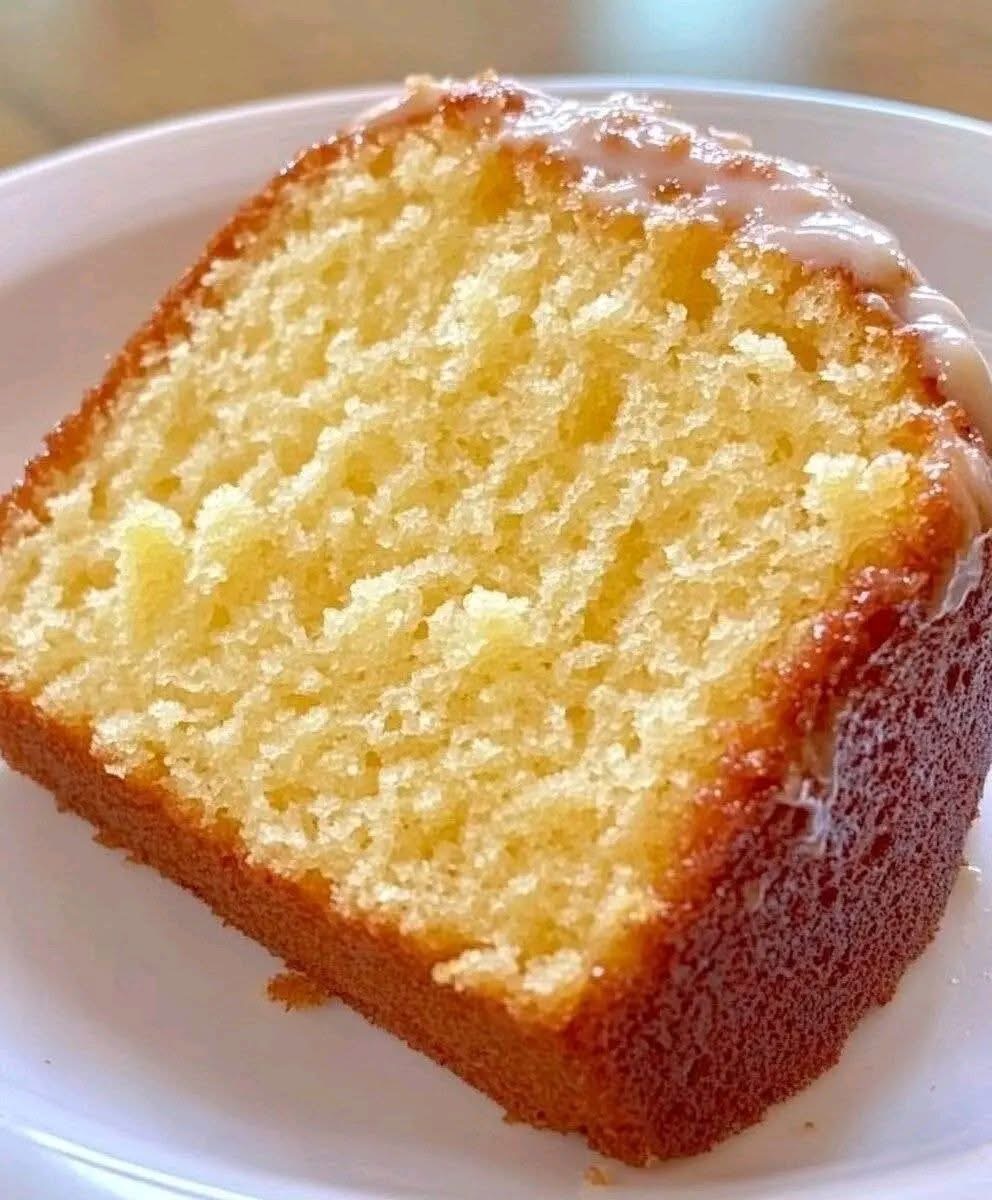This cake is beautifully balanced: rich from the butter, fluffy from the precise mixing method, and full of homemade charm. The lemon adds a fresh brightness that lifts the entire flavor profile without overpowering the buttery base. It’s the kind of recipe people come back to again and again because it’s simple, steady, and always delicious.
Whether you serve it with tea, fruit, or enjoy it as is, this pound cake will be one of your easiest “crowd-pleaser” desserts.
Ingredients
For the Cake
- 1 cup unsalted butter, softened
- 1½ cups granulated sugar
- 4 large eggs, room temperature
- 2 teaspoons vanilla extract
- 2 tablespoons lemon zest
- 3 tablespoons lemon juice
- 2 cups all-purpose flour
- 1 teaspoon baking powder
- ½ teaspoon salt
- ½ cup whole milk (or buttermilk for extra richness)
For the Glaze
- 1 cup powdered sugar
- 2 tablespoons lemon juice
- 1 tablespoon milk or cream (optional, for thinner consistency)
Instructions
1. Prepare the Pan and Oven
Preheat your oven to 350°F (175°C).
Grease a loaf pan generously with butter or non-stick spray. For easier removal, line it with parchment paper, letting the sides overhang slightly.
2. Cream the Butter and Sugar
In a large mixing bowl, beat the softened butter and sugar together for 4–5 minutes, until pale and fluffy.
This aeration step is essential—it gives your pound cake its signature soft, tender crumb.
3. Add the Eggs One at a Time
Add the eggs to the mixture, one at a time, beating well after each addition. This prevents the batter from curdling and ensures even texture.
4. Add Lemon and Vanilla
Mix in the vanilla extract, lemon zest, and lemon juice.
These ingredients add aroma, brightness, and flavor depth.
5. Combine Dry Ingredients
In a separate bowl, whisk together:
- Flour
- Baking powder
- Salt
This prevents clumps and makes the batter smooth.
6. Add Dry Ingredients and Milk Alternately
Add half of the dry mixture to the wet ingredients and mix on low speed.
Pour in the milk, then add the rest of the dry mixture.
Mix only until combined—overmixing toughens the cake.
7. Bake
Pour the batter into the prepared loaf pan.
Bake for 55 to 65 minutes, depending on your oven. The cake should be golden on top and a toothpick inserted into the center should come out clean.
8. Cool and Glaze
Let the cake cool in the pan for 10 minutes, then transfer to a wire rack.
Prepare the lemon glaze by whisking powdered sugar with lemon juice.
Drizzle the glaze over the warm cake so it sinks in slightly, adding shine and moisture.
Tips for the Perfect Pound Cake
Use Room-Temperature Ingredients
Butter, milk, and eggs at room temperature blend more smoothly into the batter, improving texture.
Measure Precisely
Too much flour leads to dryness. Spoon flour into the measuring cup and level the top.
Don’t Rush the Creaming Step
This step is the foundation of a tender pound cake. Take your time to whip the butter and sugar properly.
Bake in the Center of the Oven
This ensures even heat circulation around the cake.
Don’t Overmix at the End
When flour is added, mix just enough to incorporate. Overworking the batter leads to dense cake.
Serving Suggestions
This Lemon Butter Pound Cake is amazingly versatile. Here are some delightful ways to serve it:
- With fresh berries such as strawberries, blueberries, or raspberries
- With whipped cream for a light, dreamy finish
- Toasted lightly with a spread of butter for breakfast
- With tea or coffee in the afternoon
- As dessert with a scoop of vanilla ice cream
Its flavor pairs beautifully with fruits and mellow beverages.
Storage Instructions
Room Temperature
Store the cake in an airtight container for up to 4 days.
Refrigerator
Keeps well for 1 week. Bring to room temperature before serving for the best texture.
Freezer
Wrap slices individually in plastic wrap, then place them in a freezer bag.
Freeze for up to 3 months.
Thaw at room temperature or warm slightly in the microwave.
Variations You Can Try
1. Lemon Blueberry Pound Cake
Fold 1 cup of fresh blueberries into the batter before baking.
2. Orange Pound Cake
Swap lemon with orange zest and juice for a warm citrus flavor.
3. Almond Pound Cake
Add 1 teaspoon almond extract and sprinkle sliced almonds on top.
4. Coconut Glazed Pound Cake
Add ½ cup shredded coconut to the batter and make a coconut glaze.
Frequently Asked Questions (FAQ)
Why is it called a “pound cake”?
Traditionally, pound cakes were made with one pound each of butter, sugar, eggs, and flour. Modern recipes use adjusted proportions but still keep that rich, dense character.
My pound cake turned out dense. What happened?
You may have overmixed the batter, added too much flour, or didn’t cream the butter and sugar long enough.
Can I make this cake without the glaze?
Yes! The glaze enhances moisture and flavor, but the cake is delicious even without it.
Can I replace lemon with another flavor?
Absolutely. Vanilla, almond, orange, or even coconut make great substitutes.
How do I make it extra moist?
Adding sour cream, buttermilk, or an extra tablespoon of butter can boost moisture.
Final Thoughts
This Lemon Butter Pound Cake is a timeless dessert—simple, elegant, and always successful. Whether you’re baking for your family, preparing content for your food blog, or just craving something homemade and sweet, this recipe will quickly become a favorite.
